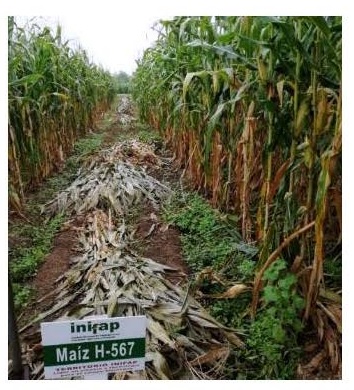Fodder productivity in corn hybrids under different plant densities and fertilization rates
DOI:
https://doi.org/10.28940/terra.v39i0.676Keywords:
trilinear hybrids, fodder production, humid tropics, Zea mays L.Abstract
Fertilization and plant density are some essential technological components in modern agriculture. The aims of this research was to define the effect of plant density and fertilization rates on fodder productivity of three commercial corn hybrids. In the spring-summer 2017 season, an experiment was established in the Cotaxtla Experimental Field of the National Institute for Forestry, Agriculture and Livestock Research (INIFAP in Spanish), under a completely randomized block design arranged in subdivided plots with three replicates. Three factors were studied, fertilization rates (207-69-60 and 253-69-60), corn hybrids (H-564C, H-567 and HE-3B) and plant densities (62 500, 83 000 and 100 000 plants ha-1). During the study period, the accumulated monthly precipitation was 1003.6 mm and average temperature was 26.7 °C; the maximum temperature occurred in August (28.7 °C) and the minimum in November (25.3 °C) 2017. Duncan’s test (P ≤ 0.05) showed that the fertilization rates integrated by the formula 253‑69‑60 increased green fodder yield, 15.06% more than in the formula 207-69-60. Hybrids H-564C and HE-3B expressed the best green fodder yields with 53 105 and 51 937 kg ha-1, respectively. Increasing plant density (62 500 to 100 000 plants ha‑1) and green fodder yield when high units of N were applied (253-69-60). Likewise, the increase in plant density did not affect the agronomic characteristics of the evaluated hybrids. The commercial H-564C hybrid expressed the highest green and dry fodder yields, followed by the experimental HE-3B hybrid. This last material is a candidate to be released and commercialized for fodder purposes in the tropical area of the state of Veracruz.
Downloads
Publication Facts
Reviewer profiles N/A
Author statements
- Academic society
- Terra Latinoamericana
- Publisher
- Mexican Society of Soil Science, C.A.

















